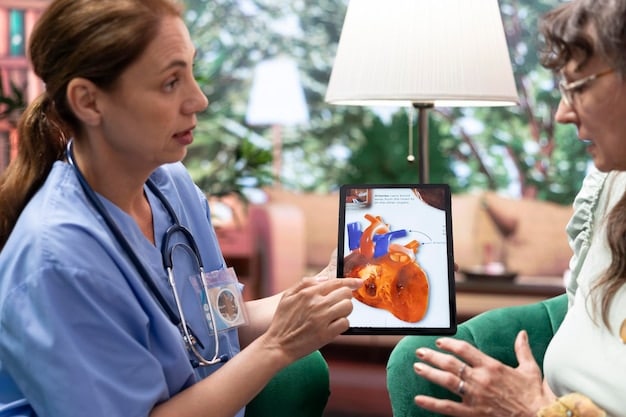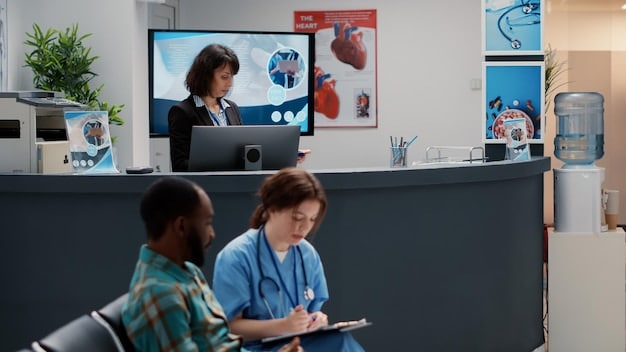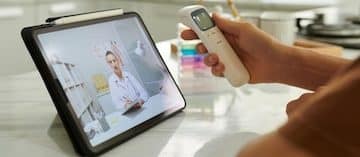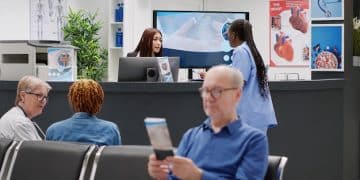Telehealth & Cardiology: Remote Heart Monitoring Solutions

Telehealth and cardiology converges to offer remote monitoring and management of heart conditions, revolutionizing patient care through technology and enabling timely interventions.
The convergence of telehealth and cardiology is transforming how heart conditions are monitored and managed. As healthcare evolves, remote solutions become increasingly vital for delivering accessible and effective care. This article explores the various facets of telehealth in cardiology, highlighting its benefits, applications, and future potential.
The Rise of Telehealth in Cardiology
Telehealth, the delivery of healthcare services remotely via technology, is rapidly changing cardiology. It addresses challenges like geographic barriers and limited access to specialists. This shift is not just about convenience; it’s about enhancing patient outcomes and redefining cardiac care.
What is Telecardiology?
Telecardiology involves using telehealth technologies to provide cardiac care from a distance. This includes remote monitoring, virtual consultations, and real-time data analysis. It’s a flexible approach that enhances traditional cardiology practices.
- Remote Monitoring: Continuous tracking of vital signs such as heart rate, blood pressure, and ECG.
- Virtual Consultations: Online appointments for diagnosis, treatment planning, and follow-ups.
- Data Analysis: Advanced algorithms analyze real-time data for early detection of abnormalities.

Telecardiology improves access to specialized care, especially for patients in rural areas. It also enhances patient engagement and adherence to treatment plans. The technology enables proactive management, reducing the need for emergency interventions.
Benefits of Remote Heart Monitoring
Remote heart monitoring offers numerous advantages over traditional in-person visits. These benefits span from economic savings to improved patient outcomes, making it an invaluable tool in modern cardiology.
Economic Advantages
Telehealth reduces costs associated with hospital readmissions and in-person clinic visits. It also minimizes travel expenses for patients, making healthcare more affordable.
Improved Patient Outcomes
Continuous monitoring allows for early detection of cardiac issues, leading to timely interventions and better health outcomes. Patients with chronic conditions like heart failure benefit significantly from this proactive approach.
- Real-Time Data: Enables quick response to critical changes in a patient’s condition.
- Personalized Care: Tailored treatment plans based on individual patient data.
- Enhanced Adherence: Regular monitoring motivates patients to follow their treatment plans.
Telehealth fosters a stronger connection between patients and healthcare providers, promoting better communication and a collaborative approach to care. This ultimately leads to improved patient satisfaction and overall well-being.
Applications of Telehealth in Cardiology
Telehealth has broad applications in managing various heart conditions. From chronic diseases to post-operative care, it provides comprehensive support to patients and healthcare providers alike.
Management of Chronic Heart Conditions
Telehealth is particularly effective in managing conditions such as heart failure and hypertension. Remote monitoring enables healthcare providers to track vital signs and adjust medications as needed.
Post-Operative Care
Patients recovering from cardiac surgery benefit from remote monitoring, which helps detect complications early and reduces the need for hospital readmissions. Virtual consultations provide ongoing support and guidance during the recovery process.

- Medication Adherence: Telehealth tools help patients manage their medications effectively.
- Lifestyle Management: Virtual coaching supports healthy lifestyle changes, such as diet and exercise.
- Early Intervention: Timely detection of warning signs prevents serious complications.
The versatility of telehealth makes it an essential tool in delivering comprehensive cardiac care, improving patient outcomes, and enhancing the efficiency of healthcare systems.
Technologies Used in Telecardiology
Telecardiology utilizes a variety of technologies to deliver remote care. These tools range from wearable devices to mobile apps, all designed to enhance patient monitoring and communication.
Wearable Monitoring Devices
Wearable devices, such as smartwatches and ECG monitors, continuously track vital signs and transmit data to healthcare providers. These devices are user-friendly and provide valuable insights into a patient’s cardiac health.
Mobile Health Applications
Mobile apps enable patients to track their symptoms, manage medications, and communicate with their healthcare team. These apps promote patient engagement and empower individuals to take control of their health.
- Data Security: Ensuring the privacy and security of patient data is paramount.
- Interoperability: Seamless integration of telehealth platforms with existing healthcare systems.
- User Experience: Designing technologies that are easy to use and accessible to all patients.
By leveraging these technologies, telecardiology enhances the quality and accessibility of cardiac care, making it a valuable tool in modern healthcare.
Challenges and Solutions in Telehealth Cardiology
Despite its many benefits, telehealth faces several challenges, including data security concerns and the digital divide. Addressing these issues is crucial for the widespread adoption of telehealth.
Data Security and Privacy
Ensuring the privacy and security of patient data is a top priority. Telehealth platforms must comply with HIPAA regulations and implement robust security measures to protect sensitive information.
The Digital Divide
Not all patients have access to the technology needed for telehealth. Bridging the digital divide requires providing affordable internet access and user-friendly devices to underserved populations.
- Training and Support: Providing adequate training and support to both patients and healthcare providers.
- Regulatory Issues: Navigating the complex landscape of telehealth regulations and reimbursement policies.
- Integration with EHRs: Ensuring seamless integration of telehealth data with electronic health records.
Overcoming these challenges will pave the way for the widespread adoption of telehealth, improving healthcare access and outcomes for all patients.
The Future of Telehealth in Cardiology
The future of telehealth in cardiology is promising, with ongoing advancements in technology and increasing acceptance among patients and healthcare providers. Telehealth is poised to play an even greater role in cardiac care.
Artificial Intelligence and Machine Learning
AI and machine learning algorithms can analyze vast amounts of data to predict cardiac events and personalize treatment plans. These technologies enhance the precision and effectiveness of telehealth interventions.
Expanding Access to Care
Telehealth will continue to expand access to cardiac care, particularly for patients in rural areas and those with limited mobility. It will also improve the efficiency of healthcare systems and reduce costs.
- Enhanced Patient Engagement: Telehealth tools will empower patients to take an active role in their healthcare.
- Proactive Management: Continuous monitoring will enable early detection and prevention of cardiac issues.
- Integration with Traditional Care: Telehealth will complement traditional in-person care, providing a comprehensive approach to cardiac health.
Telehealth is revolutionizing cardiology, offering innovative solutions for monitoring and managing heart conditions. By embracing these technologies, healthcare providers can improve patient outcomes and transform the delivery of cardiac care.
| Key Aspect | Brief Description |
|---|---|
| 🧑⚕️ Remote Monitoring | Continuous tracking of vital signs for early detection of cardiac issues. |
| 🩺 Virtual Consultations | Online appointments for diagnosis, treatment planning and follow-ups. |
| 📱 Mobile Health Apps | Tools for medication management, symptom tracking, and communication with healthcare providers. |
| 💡 Future Trends | AI and machine learning for predicting and personalizing cardiac care. |
Frequently Asked Questions (FAQ)
▼
Remote heart monitoring involves using wearable devices or implanted monitors to continuously track vital signs. This data is transmitted to healthcare providers for analysis and timely intervention.
▼
Virtual cardiology consultations improve access to care, reduce travel time, and provide flexible appointment scheduling. They also facilitate better communication between patients and healthcare providers.
▼
Telehealth cardiology platforms use robust security measures to protect patient data. They comply with HIPAA regulations and implement encryption and access controls to ensure privacy.
▼
Telehealth is effective for managing various heart conditions, including chronic diseases, post-operative care, and preventive cardiology. However, some conditions may require in-person evaluation.
▼
AI algorithms analyze patient data to predict cardiac events, personalize treatment plans, and improve the accuracy of diagnoses. This enhances the precision and efficiency of telehealth interventions.
Conclusion
In conclusion, telehealth and cardiology are converging to create innovative solutions for remote monitoring and management of heart conditions. By embracing these technologies, healthcare providers can improve patient outcomes, enhance access to care, and transform the delivery of cardiac services.





